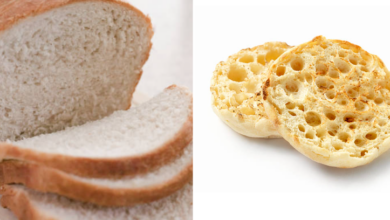White Bread Vs Multigrain Bread: What’S The Difference?
What To Know
- While white bread may not be as nutrient-rich as multigrain bread, it can still be part of a healthy diet when consumed in moderation.
- If you’re looking for a bread that is low in fiber and easy to digest, white bread may be a suitable option.
- Both white bread and multigrain bread have a place in a balanced diet.
When it comes to choosing bread, you’re faced with a myriad of options, from classic white bread to hearty multigrain bread. While both have their place in a balanced diet, understanding their nutritional differences can help you make informed choices that align with your health goals. This comprehensive guide delves into the nutritional profiles, health benefits, and drawbacks of white bread and multigrain bread, empowering you to make informed decisions about your daily bread consumption.
Nutritional Profiles
White Bread
White bread is typically made from refined wheat flour, which has been stripped of its bran and germ, resulting in a finer texture and milder flavor. This process also removes essential nutrients, such as fiber, vitamins, and minerals. As a result, white bread is lower in fiber and nutrients compared to other bread varieties.
Multigrain Bread
Multigrain bread is made from a combination of whole grains, such as wheat, oats, barley, and rye. Whole grains retain their bran and germ, which are rich in fiber, vitamins, minerals, and antioxidants. These nutrients contribute to the darker color and denser texture of multigrain bread compared to white bread.
Health Benefits
White Bread
While white bread may not be as nutrient-rich as multigrain bread, it can still be part of a healthy diet when consumed in moderation. White bread provides carbohydrates, which are the body’s primary source of energy. It can also be fortified with vitamins and minerals, such as folic acid and iron, to enhance its nutritional value.
Multigrain Bread
Multigrain bread offers a range of health benefits due to its higher fiber content. Fiber helps promote digestive health, regulates blood sugar levels, and aids in weight management. The whole grains in multigrain bread are also a good source of essential vitamins, minerals, and antioxidants, which support overall health and well-being.
Drawbacks
White Bread
The primary drawback of white bread is its low nutritional value compared to other bread varieties. Its refined nature means it lacks fiber and essential nutrients, which can contribute to blood sugar spikes and increased hunger. Additionally, some white bread products may contain added sugars and unhealthy fats, further diminishing their nutritional value.
Multigrain Bread
While multigrain bread is generally considered healthier than white bread, it may not be suitable for everyone. Some individuals may experience digestive discomfort due to the higher fiber content. Additionally, multigrain bread tends to be denser and less fluffy than white bread, which may not appeal to everyone’s taste preferences.
Making an Informed Choice
When choosing between white bread and multigrain bread, consider your individual dietary needs and preferences. If you’re looking for a bread that is low in fiber and easy to digest, white bread may be a suitable option. However, if you prioritize fiber intake and overall nutritional value, multigrain bread is the clear winner.
Tips for Choosing Healthier Bread
1. Look for bread labeled “whole grain” or “100% whole wheat.”
2. Check the ingredient list to ensure whole grains are listed first.
3. Choose bread with at least 3 grams of fiber per serving.
4. Limit bread consumption if you have digestive issues or blood sugar concerns.
5. Consider making your own bread using whole grain flour.
The Final Word: Making Bread a Part of a Balanced Diet
Both white bread and multigrain bread have a place in a balanced diet. The key is to consume them in moderation and prioritize whole grain options whenever possible. By understanding the nutritional differences between white bread and multigrain bread, you can make informed choices that support your overall health and well-being.
Frequently Asked Questions
Q: Is white bread bad for you?
A: White bread is not inherently bad for you, but it is lower in nutrients compared to other bread varieties. Consuming white bread in moderation as part of a balanced diet is generally acceptable.
Q: Is multigrain bread healthier than white bread?
A: Yes, multigrain bread is generally considered healthier than white bread due to its higher fiber content and nutrient profile. Whole grains provide essential vitamins, minerals, and antioxidants that support overall health.
Q: Can I eat white bread if I have diabetes?
A: If you have diabetes, it is recommended to limit your intake of white bread and other refined grain products. White bread can cause blood sugar spikes, which can be problematic for individuals with diabetes. Opt for whole grain bread instead.
Q: Is multigrain bread good for weight loss?
A: Multigrain bread can be a part of a weight loss diet due to its higher fiber content. Fiber helps promote satiety and fullness, which can lead to reduced calorie intake and weight management.
Q: Can I make my own whole grain bread at home?
A: Yes, you can make your own whole grain bread at home using whole grain flour. This allows you to control the ingredients and ensure the bread is made with high-quality, nutritious ingredients.


